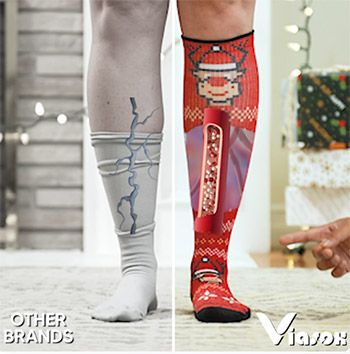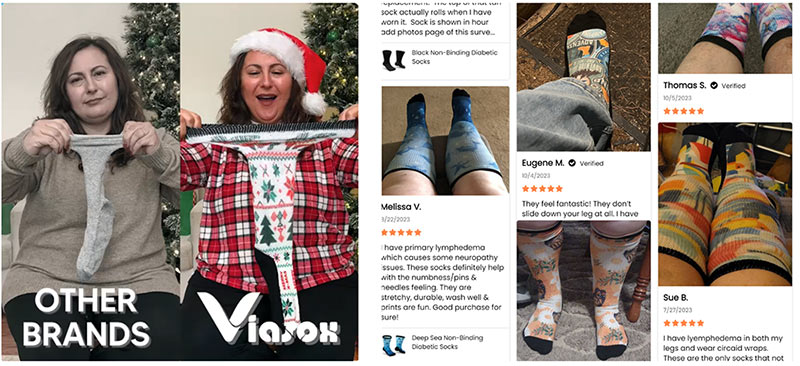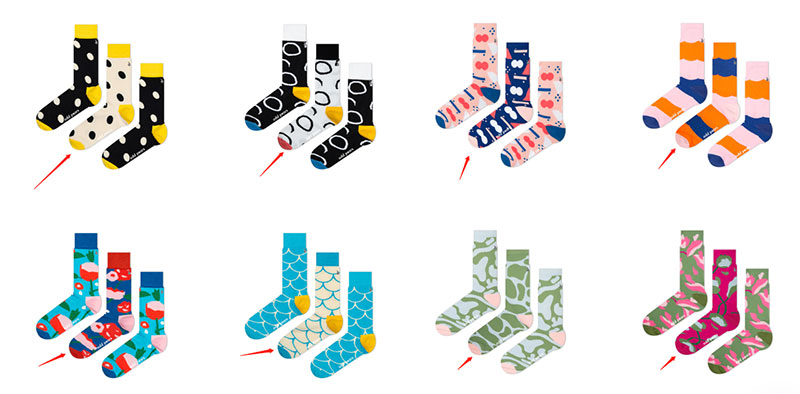For most people, selling socks seems like a boring business. Regular athletic socks we get from Chinese factories cost about $0.3 to $0.7, and the retail price is only $2 to $3. Regardless of how they are sold, the profit is very low. Newbies rarely purchase socks from us; most clients have been in the sock business for at least 10 years. Recently, our client John shared a successful sock business and asked us to find a factory for similar socks.
We researched this company and found that they sell a pair of socks for $20 to $30, making around $700,000 monthly!! This challenges our usual thinking about socks. The company,Viasox, is based in the United States and uniquely focuses on a niche audience – individuals with diabetes. They design socks specifically to protect their foot health.
How diabetic foot forms and its symptoms
Diabetic foot is a complication of diabetes. Prolonged high blood sugar levels in individuals with diabetes can contribute to damage to blood vessels and nerves in the lower limbs. Vascular damage slows down blood flow, causing foot ischemia; nerve damage reduces sensation, leading to painless ulcers. People with diabetes-related foot issues cannot wear regular socks, as they might constrict too tightly, affecting blood circulation and worsening foot ulcers.

How Viasox designs and markets diabetic socks
Viasox has addressed the pain points of people with diabetic feet by designing non-binding socks and compression socks. Compression socks are tailored for those with mild foot ischemia but without ulcers. Non-binding socks are designed for individuals with severe foot ulcers who need loose and breathable socks, particularly around the sock cuff. This helps alleviate numbness, tingling, sharpness, burning, or similar pains in their legs or feet.
Additionally, Viasox has enhanced the appearance of their socks. Instead of only using black, white, and gray colors like most diabetic socks in the market, they have styles with colorful patterns, offering both fashionable and practical designs.
A good product needs effective marketing strategies. Viasox attracts traffic mainly through website SEO and Facebook, where they boast 23,000 followers. Their website displays many positive reviews and presents how their socks have a comfortable fit by comparing them with other brands. This instills trust and stimulates consumer desire for their products.

What diabetic socks cost in Chinese factories
I guess you must be very curious about the differences between these socks and regular ones and how much it would cost to produce them in a Chinese factory. Do these socks have high technology? To understand this better, we consulted our sourcing expert Annie. Let’s take a look at her analysis.
Annie has previously worked at one of China’s largest sock factories, BONAS. With over 10 years of experience in customizing socks, she has served numerous brands such as Uniqlo, New Balance, Champion, Wilson, and more.
She said:
The production cost of regular athletic socks in China ranges from $0.3 to $0.7, while Viasox socks cost $1 to $1.5. The manufacturing process is similar to regular socks, but differences lie in the weight of the socks, pattern printing technology, packaging, and production machinery.
Sock Weight: You might think materials are the main factor affecting costs, but in reality, socks are mostly made from materials like cotton, polyester, nylon, spandex, etc., just in different proportions. Weight is the key factor significantly influencing costs. The higher the weight, the higher the cost. Viasox socks are about 40% heavier than a pair of regular socks.
Pattern Printing Technology: Viasox socks feature complex and vibrant patterns created through digital printing. This method costs $0.3-$0.4 more compared to traditional plain weave and regular mechanical weaving techniques.
Production Machinery: In China, these diabetic socks are a kind of compression socks. The machines used to produce these socks are imported from Italy, costing around $40,000. In contrast, machines to manufacture regular socks in China costs only $10,000 to $14,000.
What kind of niche socks yield high profits
We’ve noticed that many profitable sock businesses often emphasize both functional and emotional value. For example, functional socks like those designed for diabetic patients, yoga enthusiasts, or featuring antibacterial and odor-resistant properties. And examples like gift-worthy socks, metaverse socks, anime-themed socks, and collaboration socks with intellectual property – they’re all about the feels. It’s not just about socks; it’s about expressing your unique taste. Let’s dive into two real-life examples together:
Oddpears from Australia creates vibrant, artistically patterned socks for young people. They aim to shun social norms and encourage self-expression. Interestingly, they don’t sell socks in pairs. Instead, they sell a grouping of three socks, two that match and one that is slightly (inversely) odd. These socks sell at $12 to $13, however, adding an extra one costs less than $1 in production.
This is similar to the model of LittleMissMatched in the United States. LittleMissMatched used to produce 3 mismatched socks in a pack for girls aged 8-12, each with a different pattern.

In China, a 26-year-old guy noticed nightclub products were popular. He came up with a creative idea: designing disco-themed stockings for young women who love dancing at nightclubs. These stockings are regular ones adorned with rhinestones, letters, and other accessories, creating a sexy and shiny look under nightclub lights. The cost of producing these stockings is less than $1, with the rhinestone cost making up 70%. They sell for around $5 in China, with profits approximately 10 times higher than regular socks. In just one year, he earned $22 million.

We'd like to hear from you
Jingsourcing is a leading Chinese sourcing company that helps medium and small businesses import from China. In our daily blogs, we share real-life case studies of our clients, insights and tips on Chinese sourcing, as well as interesting stories. If you’d like to follow us to learn more, feel free to subscribe.

I was recommended this website by my cousin. I am not sure whether this post is written by him as nobody else know such detailed about my difficulty. You are wonderful! Thanks!
Hi, I am very much interested in discussing this business with you, I am based in the United Kingdom (UK), can you tell me a good time to call you and I look forward to speaking with you. Kind regards, Ibz Lawal
Hi, thank you for your comment! For a quicker and more efficient response, we recommend submitting a ticket with the details of your inquiry by clicking here.
Encouraging! Can you post case studies of products that are easy to use, low cost of manufacturing like sosks and boast high gross margins?
Thank you for your comment. We’ve been consistently posting similar content on our blog and various social media platforms like TikTok, Instagram, YouTube, and Facebook. You are very welcome to follow us!